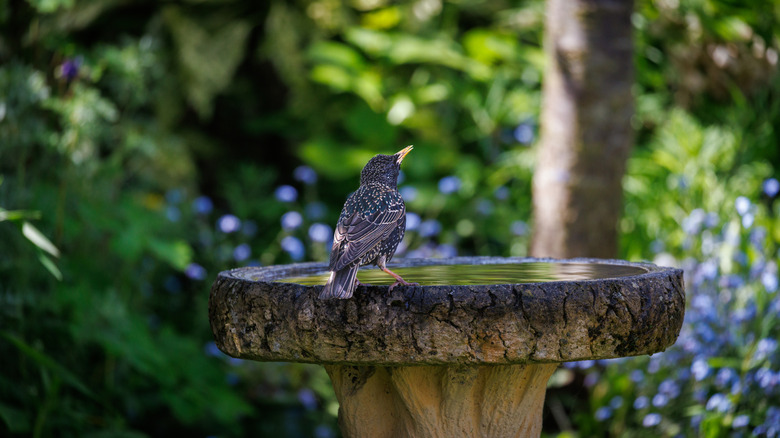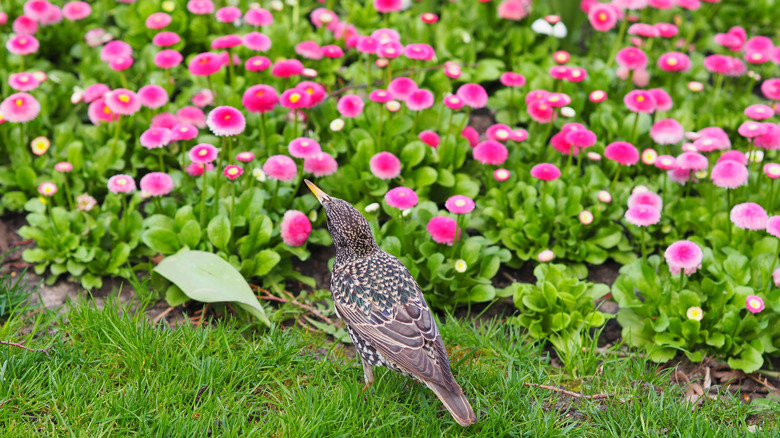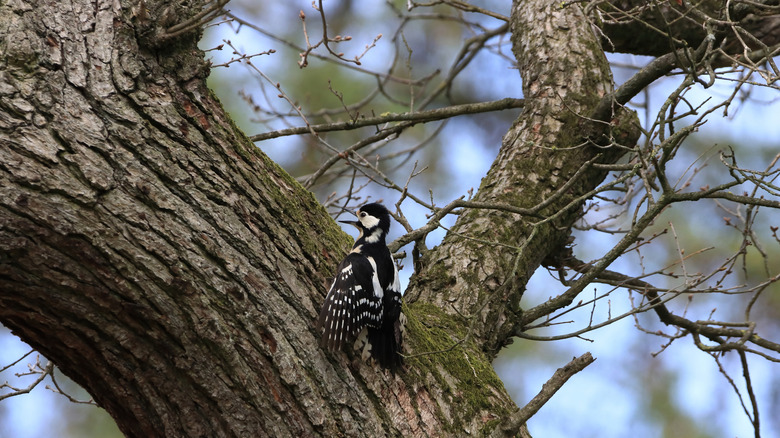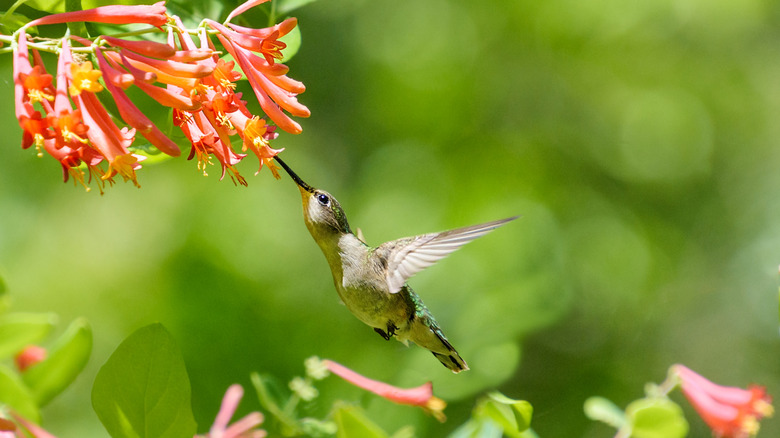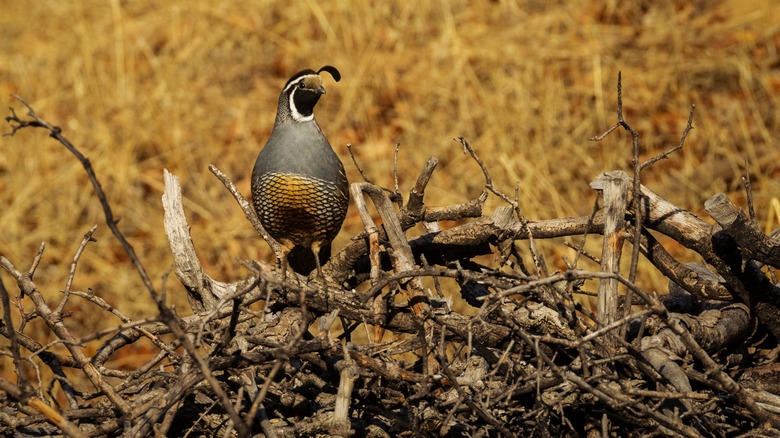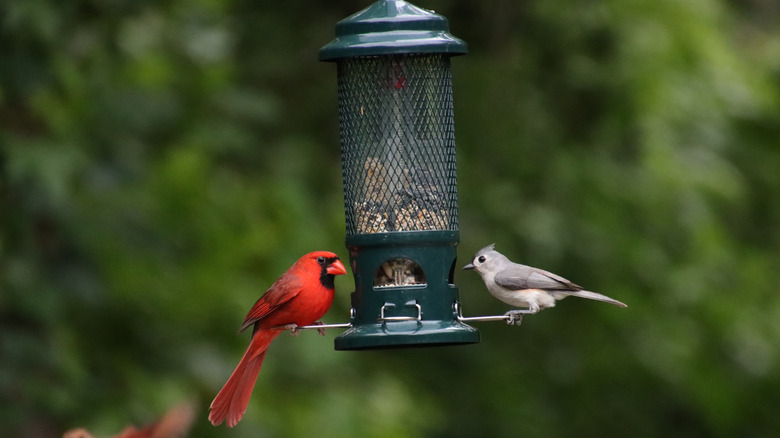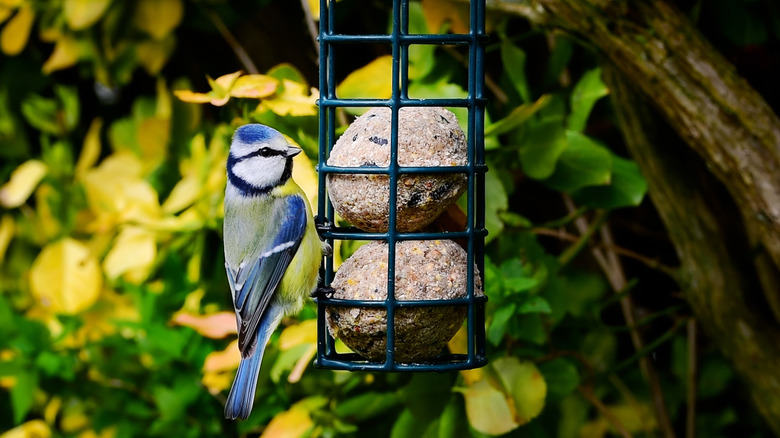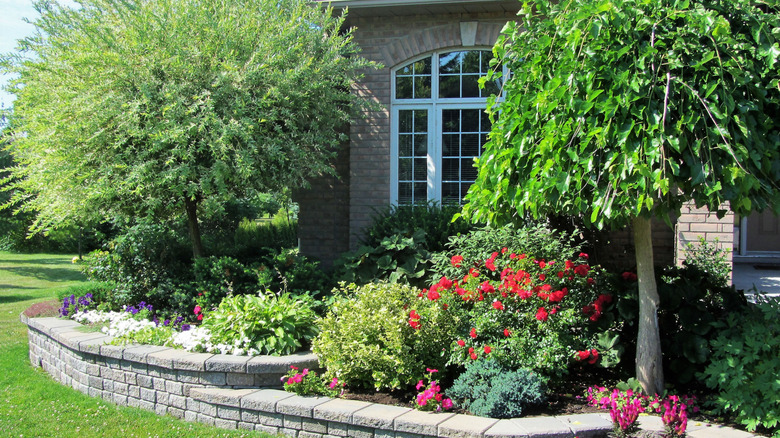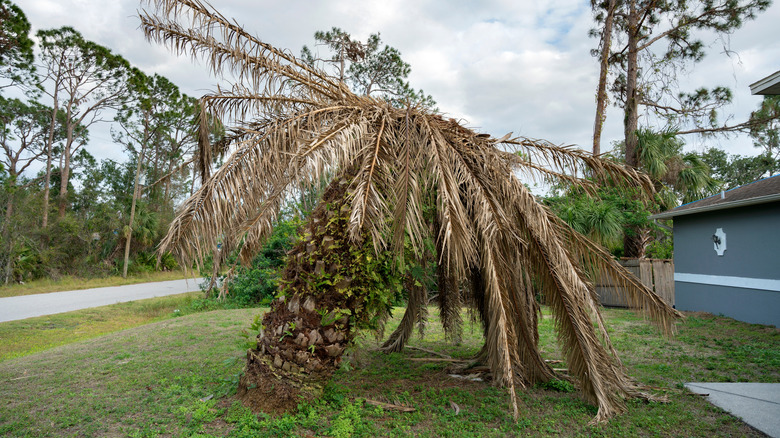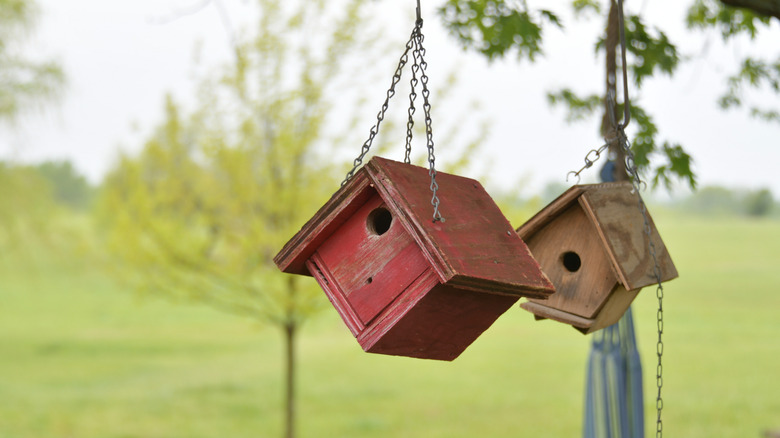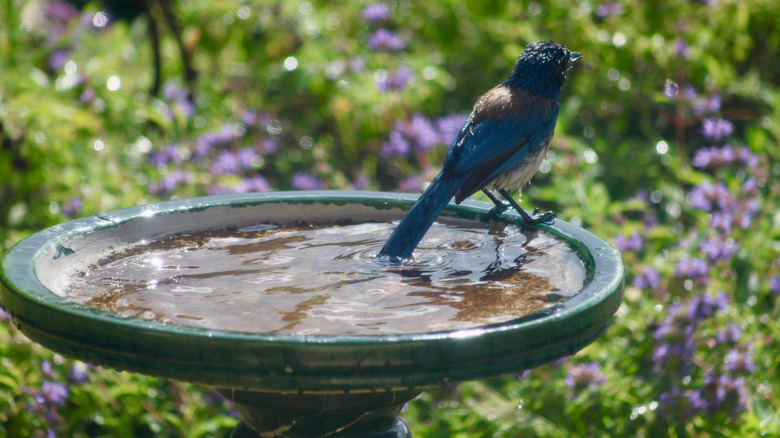Tips For Attracting A More Diverse Variety Of Birds To Your Yard
We may receive a commission on purchases made from links.
You feel like you've done it all — planted bird-friendly flowers and topped off the expensive seed mixes in the feeders. Yet, your yard only attracts a rowdy bunch of bluejays and a lone cardinal. How infuriating! Fortunately, there are ways to turn this situation around. For starters, keep in mind that a one-size-fits-all approach doesn't attract a wider variety of birds. Over time, different bird species have developed specific needs for food, shelter, nesting sites, and water. By catering to these requirements, you can attract a variety of feathered visitors.
For a targeted approach, create a list of birds that live in or migrate through your area. Your local birding society, eBird's guide, or CornellLab's Merlin app can provide region-specific information. Once you identify the relevant birds, adjust your yard according to their habitat requirements. But if you prefer a more general approach, focus on creating "habitat heterogeneity" in your yard. Grow native plants, offer varied food sources, create multi-leveled plantings, and provide running water sources. Excited to get started? The following birdscaping tips will turn your yard and garden into a bird haven, bringing in a broader range of species.
Intersperse a mix of plantings that provide seeds, nectar, fruits, and insects
Not all avian species consume seeds. In fact, many birds depend on nectar, fruits, berries, nuts, spiders, worms, and insects (either exclusively or in combination) to meet their dietary requirements. Knowing this, the easiest way to attract a greater diversity of birds is to offer a variety of their preferred food through natural plantings.
Start by adding perennial plants to your yard to attract birds year-round. Classic examples include black-eyed Susans and sunflowers. They provide seeds to goldfinches and other granivores (seed-eaters), while also hosting insects to feed insectivorous birds. Intersperse fruit-bearing shrubs, such as mulberries, redbuds, hollies, and dogwoods, to entice frugivorous (or fruit-eating) birds. Where space allows, grow wildflowers or a patchwork of meadow plantings. They'll encourage aerial insectivores (birds who feed on flying insects) like flycatchers, nightjars, swifts, and swallows to visit your yard. When it comes to trees, opt for deciduous ones like oaks and hickories to invite woodpeckers, jays, and flickers.
Although providing year-round access to diverse food sources is crucial, focus on meeting seasonal requirements when that's difficult to pull off. Insect-attracting plants are vital when the birds are breeding and feeding their offspring during spring and summer. And, seeds and fruits are essential for migratory and overwintering birds in the fall and winter.
Use native plants in your garden to encourage bird diversity
Native plants promote bird diversity more than non-native ornamentals. For one, they support many nesting avian mothers. The vast majority of bird species raise their young on a diet of insects, so they depend on a healthy supply to keep them fed. Since insects have co-evolved with native plants, one way to encourage their presence is with native vegetation. Hosting over 530 caterpillar species, oaks are perfect for attracting an array of nesting and migrating birds, including tanagers, grosbeaks, jays, and orioles. Wild cherry, plum, and maple trees are helpful, too.
In addition, many birds, like chickadees, thrushes, and warblers seem to prefer yards featuring native plants. Indigenous vegetation also provides delicious food at critical times. For instance, rose-breasted grosbeaks rely on serviceberries and elderberries to stock up their energy reserves prior to migration. Favoring their fluffy fibers and needles, many birds also gather their nesting materials from native perennials and conifers, such as thistles, asters, pines, and spruce.
That being the case, don't chop down all your non-native ornamentals. Just make sure about 70% of the plants and trees in your yard are native species. To get a list of the specific ones in your area, use a tool like Audubon's native plant finder.
Interlace your yard with colorful plants
If you favor specific hues or prefer a monochromatic look in your garden, you might want to rethink this color scheme. The reason? Many birds are drawn to flowers that match the color of their feathers. Given that, incorporating a rainbow of blooms in your garden can be immensely helpful. On the other hand, abstain from adding too many white flowers as some birds may associate this color with danger.
For example, goldfinches usually pay attention to yellow flowers, like cup plants, which provide water and seeds. They also favor giant yellow hyssop and sneezeweed. Similarly, orioles perch on nectar-rich, orange flowers, although they adore red flowers like Ocotillo too. Bluebirds may flock to penstemons, bellflowers, bluebells, and hydrangeas. However, more cautious birds like doves and quails seek plants in earthy colors (think browns and greens) for shelter.
Hummingbirds and their fabled love for the red spectrum is no secret, either. However, their reasons are slightly different from others. Since bees have a hard time locating red blooms, hummingbirds face less competition for nectar at these flowers. Besides, several red-blooming plants have evolved specific features to entice hummingbirds and aid cross-pollination. Consider adding fuchsia, cardinal flowers, and other native plants for a sustainable approach to attracting hummingbirds.
Create brush piles to attract different birds
Have you been dumping the twigs and branches that came loose during storms or were clipped off during maintenance? Instead, use the limbs to create brush piles to attract a myriad of bird species. Ground-feeding birds hunt for seeds, spiders, or insects hiding inside these habitat piles. Small birds, like Carolina wrens and warblers, may use these piles for cover and shelter, too. Cardinals, flickers, and nuthatches may also visit your yard to explore them.
Building a brush pile is simple. Stake out an area near woodland edges or where thirsty birds gather. Lay down the thickest logs (over 6 inches wide) as the foundation, spacing them 6 to 8 inches apart until they cover about 10 to 20 feet each way. Then, layer thinner branches in the opposite direction to create a staggered structure. Cover the top with brush, pine branches, and leafy twigs until it's a few feet high. Make sure the layers are loose so birds have ample entry and exit points. Keep adding to the top layer as the pile starts to break down over time.
Keep in mind that brush piles aren't suitable for all locations. They can become fire hazards, so avoid making them if you live in a wildfire-prone area. Also, if snakes, rodents, gophers, or rats often visit your yard, brush piles may amplify their nuisance since they make good hiding spots for pests.
Suspend bird feeders of varied styles at different heights
Birds have specific, height-based feeding preferences. Some, like dark-eyed juncos, starlings, and sparrows, forage on the ground. In contrast, black-capped chickadees, sapsuckers, and tufted titmice tend to feed higher up. Many other species fall somewhere in between. For example, finches, cardinals, mockingbirds, and northern flickers eat slightly above ground level. So, to welcome a greater diversity of feathered species, place their feeding stations at heights that match their natural feeding habits.
Also, experiment with different feeder styles. Platform or table models will maximize the bird species calling on your yard. Apart from the ground-feeding birds mentioned above, they'll also attract doves and quails. Just make sure they feature an attached mesh screen or baffle to keep out raiders like squirrels. If your area is home to redpolls and siskins, hang a tube or thistle feeder like Gtongoko Metal Mesh Tube Feeder about 5 feet high to attract them. Finally, suspend hopper feeders, like Nature's Way Squirrel Shield Hopper Feeder, from a branch or a pole for treetop diners. Remember to regularly clean your backyard bird feeders to prevent the spread of disease among your feathered visitors. You may consult Project FeederWatch to learn the specific feeder and food preferences of your targeted birds.
Offer a wide variety of seeds
Thanks to their biology, birds are selective about the seeds they consume. If they're large-beaked (think titmice and nuthatches), they can devour striped sunflower seeds and peanuts. But if they're small, they'll struggle to crack open these seeds due to their thick membranes. So, you should provide black oil or hulled seeds to attract them. In fact, black oil sunflower seeds are your golden ticket to inviting birds, including chickadees, finches, evening grosbeaks, nuthatches, and cardinals.
But if sunflower seeds don't bring in sufficient bird traffic, diversify your seed collection. Goldfinches, redpolls, and pine siskins are partial to nyjer seed, whereas grosbeaks prefer a blend of sunflower and safflower seeds. Similarly, draw the attention of juncos, red-winged blackbirds, and doves with white proso millets.
For best results, use separate feeders for different seed types. Otherwise, birds will pick off their favored seeds and toss aside the rest, wasting them. But if space is limited, use thoughtful blends constituting cracked corn, millet, and sunflower seeds. This way, even when a few birds toss aside everything besides the sunflower seeds, you can still attract ground-feeding birds to finish the dropped seeds. If you choose to maintain seed stations in the winter, add grit, such as crushed eggshells or sand, that birds can use to digest hard-shelled seeds.
Offer diverse foods beyond seeds to entice different birds
Leave the seed-only mindset behind and consider other food offerings to attract more bird species to your yard. To illustrate, suet or beef fat will bring in chickadees, flickers, nuthatches, titmice, woodpeckers, and wrens, especially in the winter when insects are scarce. However, avoid suet during the hot summer months when it can spoil. Instead, serve your visiting birds a "Marvel Meal." Start by mixing equal parts of peanut butter, flour, and vegetable shortening with four parts of cornmeal. Smear the blend into cavities or pine cones, or freeze it and cut it into smaller portions for feeder trays.
Also, experiment with currants and raisins. Soak them for at least half an hour (or overnight) before putting them out in platform feeders. This could draw the attention of mockingbirds, robins, and waxwings. Cut fruit — skewered on specialized fruit feeders or in other feeders, can help, too. For example, orioles can be tempted by impaling half-cut, ripe oranges on sturdy branches. Hummingbirds may fly in for fruit flies collecting around pieces of overripe bananas and melons stowed away in a mesh bag. And dried insects, like Kimoe's Natural Non-GMO Mealworms, can bring in bluebirds, scrub jays, wrens, warblers, and other species.
Create multi-leveled plantings for cover and nesting
Birds have specific height preferences for shelter and nesting. Robins tend to spend a lot of time on the ground, while cardinals and mockingbirds roam in mid-story canopies. So, grow multi-leveled plantings — a combination of tall trees, understory vegetation, shrubs, and vines at various heights — to cater to diverse bird species. Evergreens also work well as they offer year-round cover, perches, and shelter.
For larger yards, center your landscape around hardwood species like oak, maple, and elm trees. As their canopies are quite dense, tanagers, warblers, and orioles may nest inside them. Conifers like pines and spruces are also an excellent addition because they attract pine warblers, nuthatches, crossbills, and waxwings. Medium-sized trees like black gum, crabapples, dogwoods, and mulberries may be more appropriate in limited acreage, albeit they're deciduous.
You may attract more songbirds to your garden by planting beautiful shrubs like hollies, viburnums, and bayberries in hedgerows. Bluebirds, robins, and cardinals love these shrubs. Hawthorn, raspberry, and wild rose are other worthy additions. This is because their thicketed growth prevents predators from entering through thorns. Additionally, you may find these birds taking cover in yellow jessamine or Virginia creeper vines. However, keep your expectations limited since nesting birds are territorial. You'll likely attract only a few breeding pairs unless your property is quite large.
Maintain snags to encourage birds to nest, roost, feed, and perch in your yard
Leaving dying or dead trees, also called snags, in your yard can attract an assortment of birds. Many bird species use snags for nesting, roosting, and feeding. Primary cavity nesters bore into decaying wood to create nesting spaces. The diameter of the snag determines which type of flying friends it will attract. Larger ones can provide homes for pileated woodpeckers, barred owls, and silver-haired bats. However, don't be tempted to get rid of smaller snags because of their size. Hummingbirds, bluebirds, and chickadees can all take advantage of their narrower trunks.
Beyond nesting, you may attract birds, like kingbirds and woodpeckers, that are interested in using the snags as feeding and foraging sites for termites, beetles, and spiders. Clark's nutcrackers may utilize their cavities to store food. Further, keeping dead trees might let you catch the birds of prey, such as owls, eagles, and raptors, hunting their meals.
However, there are a few notable caveats. Snakes, raccoons, and squirrels may also inhabit snags, especially if they're very wide. Plus, dead trees can pose hazards if bark or branches come loose. So, keep them only if the area is clear and away from paths and structures. Or better yet, cut them down to 10-foot-tall stumps.
Install birdhouses or nest boxes with various entry hole sizes and mounting heights
While you're waiting for your multi-leveled plantings to take root, you may supplement your efforts by mounting birdhouses in your yard. After all, around 50 North American birds, including bluebirds, chickadees, and wrens, use these structures for nesting. However, you can't take a boilerplate approach as most birds have specific requirements that you must meet to attract them. Also, if you'd prefer different species to nest in your yard, such as tree swallows and bluebirds, you should space their boxes about 15 feet apart.
The design of the birdhouse itself is also important. For instance, mourning doves require shallow nest baskets. You can place them on a tree branch, shaded away from sunlight, around February. On the other hand, house wrens require small boxes like Audubon's Red Cedar Bird House. These can be suspended from high tree limbs or under eaves toward the end of April.
Since the requirements vary vastly, consider utilizing CornellLab's NestWatch Right Bird, Right House tool. If you're interested in supporting specific species, you may look up their nest plans and DIY them. Remember, if you make the size of the entry holes too large, European starlings and house sparrows may take over. If that happens, remove the birdhouses until the problematic birds move elsewhere.
Provide multiple water sources and take it up a notch by adding movement
Nothing brings different bird species together like a bird bath. They use the water for drinking, cleaning their feathers, or just frolicking about in the sunny weather. So, if you don't have a water source already, order one, like Teamson Home's Glass Pedestal Bird Bath. Made of glass, this bath may reflect sunlight, catching the attention of birds. Make sure the water is available throughout the year, paying special attention during droughts and freezing weather. Use a few clever ways to keep your bird bath from freezing in the winter, and have fun watching bluebirds and wrens sipping the cold water. To prevent birds from catching diseases, make sure to replace the water every other day and clean the bath with a vinegar solution weekly.
In addition to installing a bird bath, add movement to attract feathered friends. It could be as simple as adding a dripper, mister, or small fountain so the birds find their way by tracing the sounds. You may DIY it, too. Take a spare milk jug, drill a hole in its bottom, and fill it with water. Then, hang it above your birdbath and allow the water to drip down slowly to refill it every day. Or, place a water-filled lid on the ground for birds to grab a drink. Just be mindful to only do this in areas that household pets don't have access to.
